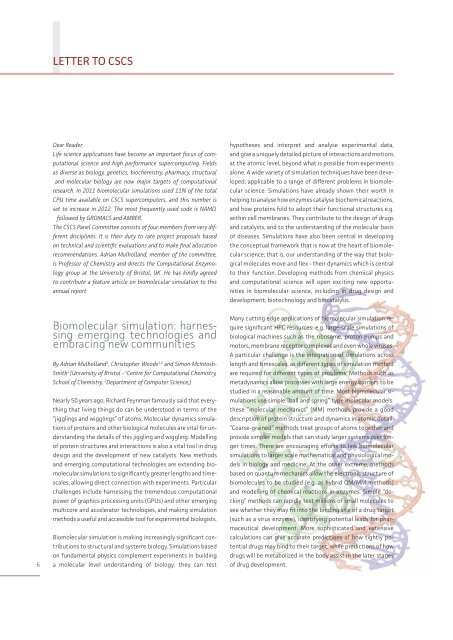Annual Report 2011 - CSCS
Annual Report 2011 - CSCS
Annual Report 2011 - CSCS
You also want an ePaper? Increase the reach of your titles
YUMPU automatically turns print PDFs into web optimized ePapers that Google loves.
6<br />
ILETTER TO <strong>CSCS</strong><br />
Dear Reader,<br />
Life science applications have become an important focus of computational<br />
science and high performance supercomputing. Fields<br />
as diverse as biology, genetics, biochemistry, pharmacy, structural<br />
and molecular biology are now major targets of computational<br />
research. In <strong>2011</strong> biomolecular simulations used 11% of the total<br />
CPU time available on <strong>CSCS</strong> supercomputers, and this number is<br />
set to increase in 2012. The most frequently used code is NAMD,<br />
followed by GROMACS and AMBER.<br />
The <strong>CSCS</strong> Panel Committee consists of four members from very different<br />
disciplines. It is their duty to rate project proposals based<br />
on technical and scientific evaluations and to make final allocation<br />
recommendations. Adrian Mulholland, member of the committee,<br />
is Professor of Chemistry and directs the Computational Enzymology<br />
group at the University of Bristol, UK. He has kindly agreed<br />
to contribute a feature article on biomolecular simulation to this<br />
annual report.<br />
Biomolecular simulation: harnessing<br />
emerging technologies and<br />
embracing new communities<br />
By Adrian Mulholland 1 , Christopher Woods 1,2 and Simon McIntosh-<br />
Smith 2 (University of Bristol - 1 Centre for Computational Chemistry,<br />
School of Chemistry, 2 Department of Computer Science,)<br />
Nearly 50 years ago, Richard Feynman famously said that everything<br />
that living things do can be understood in terms of the<br />
“jigglings and wigglings” of atoms. Molecular dynamics simulations<br />
of proteins and other biological molecules are vital for understanding<br />
the details of this jiggling and wiggling. Modelling<br />
of protein structures and interactions is also a vital tool in drug<br />
design and the development of new catalysts. New methods<br />
and emerging computational technologies are extending biomolecular<br />
simulations to significantly greater lengths and timescales,<br />
allowing direct connection with experiments. Particular<br />
challenges include harnessing the tremendous computational<br />
power of graphics processing units (GPUs) and other emerging<br />
multicore and accelerator technologies, and making simulation<br />
methods a useful and accessible tool for experimental biologists.<br />
Biomolecular simulation is making increasingly significant contributions<br />
to structural and systems biology. Simulations based<br />
on fundamental physics complement experiments in building<br />
a molecular level understanding of biology: they can test<br />
hypotheses and interpret and analyse experimental data,<br />
and give a uniquely detailed picture of interactions and motions<br />
at the atomic level, beyond what is possible from experiments<br />
alone. A wide variety of simulation techniques have been developed,<br />
applicable to a range of different problems in biomolecular<br />
science. Simulations have already shown their worth in<br />
helping to analyse how enzymes catalyse biochemical reactions,<br />
and how proteins fold to adopt their functional structures e.g.<br />
within cell membranes. They contribute to the design of drugs<br />
and catalysts, and to the understanding of the molecular basis<br />
of diseases. Simulations have also been central in developing<br />
the conceptual framework that is now at the heart of biomolecular<br />
science; that is, our understanding of the way that biological<br />
molecules move and flex - their dynamics which is central<br />
to their function. Developing methods from chemical physics<br />
and computational science will open exciting new opportunities<br />
in biomolecular science, including in drug design and<br />
development, biotechnology and biocatalysis.<br />
Many cutting edge applications of biomolecular simulation require<br />
significant HPC resources: e.g. large-scale simulations of<br />
biological machines such as the ribosome, proton pumps and<br />
motors, membrane receptor complexes and even whole viruses.<br />
A particular challenge is the integration of simulations across<br />
length and timescales, as different types of simulation method<br />
are required for different types of problems. Methods such as<br />
metadynamics allow processes with large energy barriers to be<br />
studied in a reasonable amount of time. Most biomolecular simulations<br />
use simple “ball and spring” type molecular models:<br />
these “molecular mechanics” (MM) methods provide a good<br />
description of protein structure and dynamics in atomic detail.<br />
“Coarse-grained” methods treat groups of atoms together and<br />
provide simpler models that can study larger systems over longer<br />
times. There are encouraging efforts to link biomolecular<br />
simulations to larger scale mathematical and physiological models<br />
in biology and medicine. At the other extreme, methods<br />
based on quantum mechanics allow the electronic structure of<br />
biomolecules to be studied (e.g. as hybrid QM/MM methods)<br />
and modelling of chemical reactions in enzymes. Simple “docking”<br />
methods can rapidly test millions of small molecules to<br />
see whether they may fit into the binding site of a drug target<br />
(such as a virus enzyme), identifying potential leads for pharmaceutical<br />
development. More sophisticated and extensive<br />
calculations can give accurate predictions of how tightly potential<br />
drugs may bind to their target, while predictions of how<br />
drugs will be metabolized in the body assist in the later stages<br />
of drug development.


